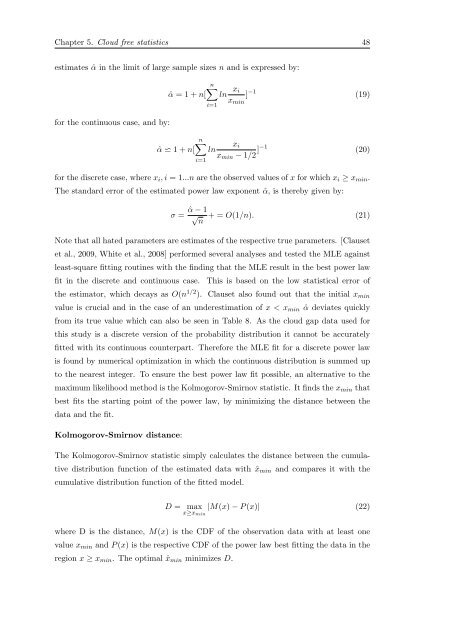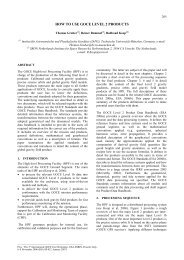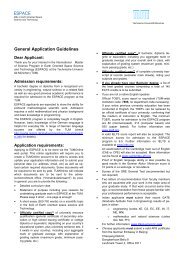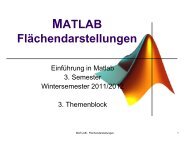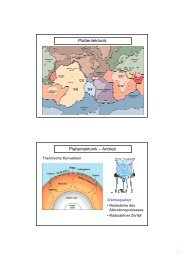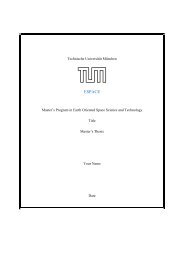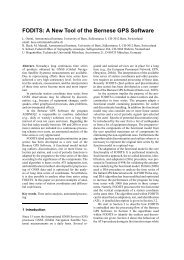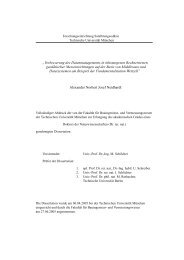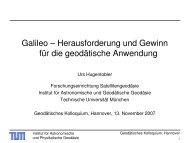Cloud Statistics from Calipso Lidar Data for the ... - espace-tum.de
Cloud Statistics from Calipso Lidar Data for the ... - espace-tum.de
Cloud Statistics from Calipso Lidar Data for the ... - espace-tum.de
You also want an ePaper? Increase the reach of your titles
YUMPU automatically turns print PDFs into web optimized ePapers that Google loves.
Chapter 5. <strong>Cloud</strong> free statistics 48<br />
estimates ˆα in <strong>the</strong> limit of large sample sizes n and is expressed by:<br />
<strong>for</strong> <strong>the</strong> continuous case, and by:<br />
ˆα = 1 + n[<br />
ˆα ⋍ 1 + n[<br />
n∑<br />
i=1<br />
ln x i<br />
x min<br />
] −1 (19)<br />
n∑ x i<br />
ln<br />
x min − 1/2 ]−1 (20)<br />
i=1<br />
<strong>for</strong> <strong>the</strong> discrete case, where x i , i = 1...n are <strong>the</strong> observed values of x <strong>for</strong> which x i ≥ x min .<br />
The standard error of <strong>the</strong> estimated power law exponent ˆα, is <strong>the</strong>reby given by:<br />
σ = ˆα − 1 √ n<br />
+ = O(1/n). (21)<br />
Note that all hated parameters are estimates of <strong>the</strong> respective true parameters. [Clauset<br />
et al., 2009, White et al., 2008] per<strong>for</strong>med several analyses and tested <strong>the</strong> MLE against<br />
least-square fitting routines with <strong>the</strong> finding that <strong>the</strong> MLE result in <strong>the</strong> best power law<br />
fit in <strong>the</strong> discrete and continuous case. This is based on <strong>the</strong> low statistical error of<br />
<strong>the</strong> estimator, which <strong>de</strong>cays as O(n 1/2 ). Clauset also found out that <strong>the</strong> initial x min<br />
value is crucial and in <strong>the</strong> case of an un<strong>de</strong>restimation of x < x min ˆα <strong>de</strong>viates quickly<br />
<strong>from</strong> its true value which can also be seen in Table 8. As <strong>the</strong> cloud gap data used <strong>for</strong><br />
this study is a discrete version of <strong>the</strong> probability distribution it cannot be accurately<br />
fitted with its continuous counterpart. There<strong>for</strong>e <strong>the</strong> MLE fit <strong>for</strong> a discrete power law<br />
is found by numerical optimization in which <strong>the</strong> continuous distribution is summed up<br />
to <strong>the</strong> nearest integer. To ensure <strong>the</strong> best power law fit possible, an alternative to <strong>the</strong><br />
maximum likelihood method is <strong>the</strong> Kolmogorov-Smirnov statistic. It finds <strong>the</strong> x min that<br />
best fits <strong>the</strong> starting point of <strong>the</strong> power law, by minimizing <strong>the</strong> distance between <strong>the</strong><br />
data and <strong>the</strong> fit.<br />
Kolmogorov-Smirnov distance:<br />
The Kolmogorov-Smirnov statistic simply calculates <strong>the</strong> distance between <strong>the</strong> cumulative<br />
distribution function of <strong>the</strong> estimated data with ˆx min and compares it with <strong>the</strong><br />
cumulative distribution function of <strong>the</strong> fitted mo<strong>de</strong>l.<br />
D = max<br />
x≥x min<br />
|M(x) − P (x)| (22)<br />
where D is <strong>the</strong> distance, M(x) is <strong>the</strong> CDF of <strong>the</strong> observation data with at least one<br />
value x min and P (x) is <strong>the</strong> respective CDF of <strong>the</strong> power law best fitting <strong>the</strong> data in <strong>the</strong><br />
region x ≥ x min . The optimal ˆx min minimizes D.


